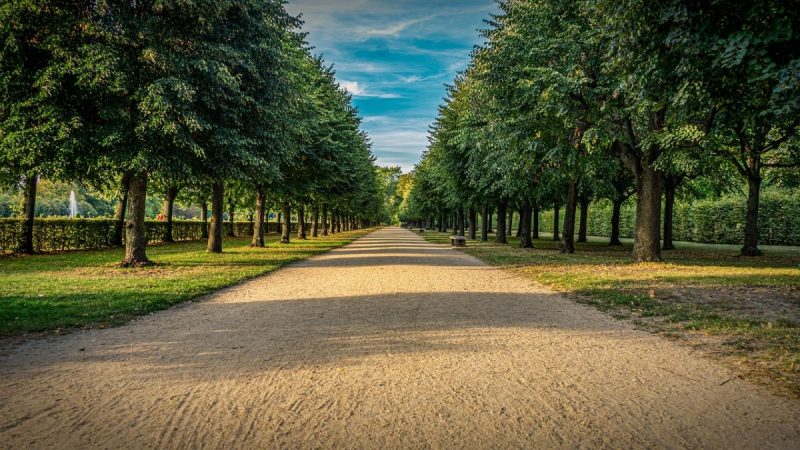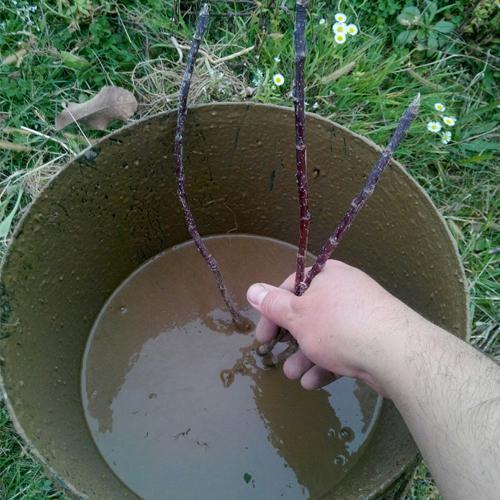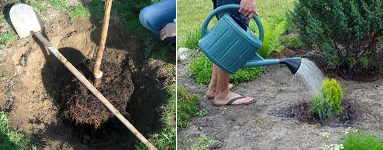Ornamental trees and shrubs – Planting guide

For most ornamental trees and shrubs, the best time for planting is during the dormancy period. The dormancy period represents that phase from the annual cycle of the plants in which their metabolic activity is minimal. In the case of ornamental trees and shrubs, this period includes the time interval between leaf fall (autumn) and the beginning of bud break (spring).
In the case of deciduous and evergreen species, planting is done in autumn, after the leaves fall (in the case of deciduous species), until spring, before budding. Planting can be done in winter if the temperature is above 5 °C and the soil is not frozen.
Coniferous species are more sensitive to the moment of planting. In their case, this operation is recommended to be done in autumn (September-October) or spring (March-April). Planting during the dormancy period gives the newly planted tree or shrub time for the proper development of the roots until the start of the vegetative growth period.
How to Plant Trees and Shrubs
The planting place needs to be chosen according to the environmental requirements of the tree or shrub (light, humidity, soil). It is recommended that the dimensions of the planting hole be double that of the root ball. Depending on the species, planting can be done with a bundle of soil on the roots or without soil on the roots.
Planting trees and shrubs with root ball has the advantage that the degree of success is higher. This type of planting is mandatory for:
- deciduous species with evergreen leaves (e.g. Berberis julianae, Euonymus japonicus, etc.);
- species with semi-persistent, mature leaves (e.g. Ligustrum vulgare, Lonicera pileata, etc.);
- species sensitive to transplanting (e.g. Magnolia, Betula, etc.);
- deciduous species, of mature age;
- coniferous species (e.g. Abies, Picea, Thuja, Juniperus etc).
Before planting, it is recommended to remove any cover from around the root or trunk, if it is not biodegradable, because it prevents the development of roots in the soil. The cover must be removed carefully so that the roots are not affected.
The tree or shrub is placed in the existing hole so that the plant is in a vertical position. After that, fill the hole gently but firmly. It is important to pack soil around the base of the root ball to stabilize it. Also, it will be necessary to fill the hole firmly to eliminate air pockets.
Trimming
Root trimming does not apply to plants with the root ball. Pruning of the above-ground portion never applies to conifers, but only to species of deciduous trees and shrubs. Small cuts can be done, to balance the above-ground parts with the root part, keeping the shape and volume of the crown.
Planting trees and shrubs without earth on the roots is suitable for species of ornamental trees and shrubs that are not sensitive to transplanting or do not have any special requirements for this type of operation.
A particularity of planting without soil on the roots is the mudding operation, which is mandatory for this type of planting.
By mudding, we mean soaking the roots before planting for about 15 minutes in a mixture of water, ground earth, and fresh cattle manure. This operation has the role of rehydrating the roots and promoting a better rate of success when planting.
Before the actual planting, at the base of the hole, a mound made up of ground earth needs to be built, which has the function of promoting a good development of the roots. For the same purpose, before placing the roots in the hole, it is recommended to water the soil at the base of the hole.
The positioning of the plant in the hole has to be done so that the level of the soil corresponds to the previous one.
Trimming. Before soaking the roots, shorten the very long ones and remove the broken or injured ones. The trimming of the roots favors a better success rate when planting. The pruning of the above-ground part is more intense in the case of the plants without soil on the roots than in the case of those with a root ball, because in this situation, the volume of the roots is smaller and cannot ensure the supply of the entire aerial part.
Watering
After planting, it is necessary to carry out a thorough watering. Depending on the volume of the root system, the recommended dose is 5-10 l of water or even more, if necessary. At the same time with the first watering, a rooting stimulator can be applied.
Recommended products
-
You can find products on a different store
Change Store -
You can find products on a different store
Change Store -
You can find products on a different store
Change Store -
You can find products on a different store
Change Store -
You can find products on a different store
Change Store -
You can find products on a different store
Change Store -
You can find products on a different store
Change Store -
You can find products on a different store
Change Store -
You can find products on a different store
Change Store -
You can find products on a different store
Change Store -
You can find products on a different store
Change Store -
You can find products on a different store
Change Store -
You can find products on a different store
Change Store -
You can find products on a different store
Change Store -
You can find products on a different store
Change Store -
You can find products on a different store
Change Store -
You can find products on a different store
Change Store -
You can find products on a different store
Change Store -
You can find products on a different store
Change Store -
You can find products on a different store
Change Store -
You can find products on a different store
Change Store -
You can find products on a different store
Change Store -
You can find products on a different store
Change Store -
You can find products on a different store
Change Store
In the first year after planting, moderate humidity must be maintained in the soil, so that it remains moist. Still, the water should not puddle, since excessive watering leads to the suffocation of the root and its rot.
If in the winter after planting there are consecutive days with high temperatures and no precipitation, it is recommended to administer a moderate amount of water, to prevent dehydration of the newly planted trees or shrubs.
Fertilization
Fertilizers are not recommended during planting or immediately after planting. But, if the soil is poor in nutrients, some garden earth can be incorporated into the soil removed from the hole. In the first week after planting, a product can be administered to improve the soil structure. Fertilization will be done after the roots have adapted to the new environment, with specific slow-release fertilizers.
Recommended products
-
You can find products on a different store
Change Store -
You can find products on a different store
Change Store -
You can find products on a different store
Change Store -
You can find products on a different store
Change Store -
You can find products on a different store
Change Store -
You can find products on a different store
Change Store -
You can find products on a different store
Change Store -
You can find products on a different store
Change Store -
You can find products on a different store
Change Store -
You can find products on a different store
Change Store -
You can find products on a different store
Change Store -
You can find products on a different store
Change Store -
You can find products on a different store
Change Store -
You can find products on a different store
Change Store -
You can find products on a different store
Change Store -
You can find products on a different store
Change Store -
You can find products on a different store
Change Store -
You can find products on a different store
Change Store -
You can find products on a different store
Change Store -
You can find products on a different store
Change Store -
You can find products on a different store
Change Store -
You can find products on a different store
Change Store -
You can find products on a different store
Change Store -
You can find products on a different store
Change Store
Trees and Shrubs anchoring
For a harmonious development, it is recommended to anchor large trees and tutor those of lower height.
How to choose the planting material
For the proper development of the tree or shrub to be planted, it is recommended that the planting material be carefully checked at the time of purchase. It is recommended that it be bought from authorized nurseries or specialized dendrological centers.
At the time of purchase, attention will be paid to several aspects:
Shape. The crown should be well proportioned, with vigorous and airy branches.
Leaves. Their color and appearance are a very important indication of the plant’s health. A healthy plant has rich, colorful foliage depending on the species.
Wounds. Their existence is an indication that the plant is not in very good condition. Even if at that moment, there are no signs of illness, the lesions can be gateways for various diseases and pests.
Roots. If the root system is affected or poorly developed, the plant may not develop properly or even dry out over time.
Healthy roots should be white or brown, well-hydrated, and numerous. Broken, dehydrated, discolored, or blackened roots are indications that the plant is already affected by a disease and cannot properly develop.
In the case of conifers and deciduous species sensitive to transplanting, it is recommended to purchase them in pots. This way, you can check the root system of plants, which must be developed proportionally to the age of the tree. If the root system is not developed properly or the roots have been severely shaped before purchase, it is possible that at some time after planting, the tree will begin to dry irreversibly, for no apparent reason.


















































































































































































































































































































































































































































